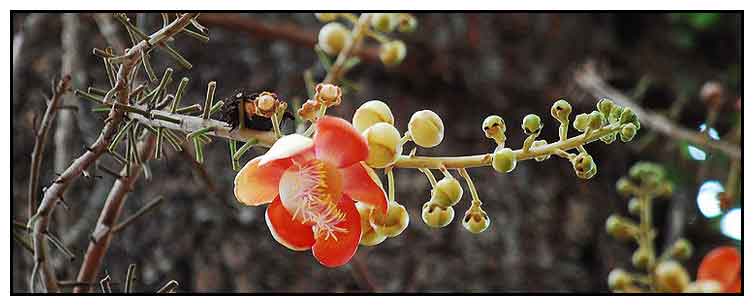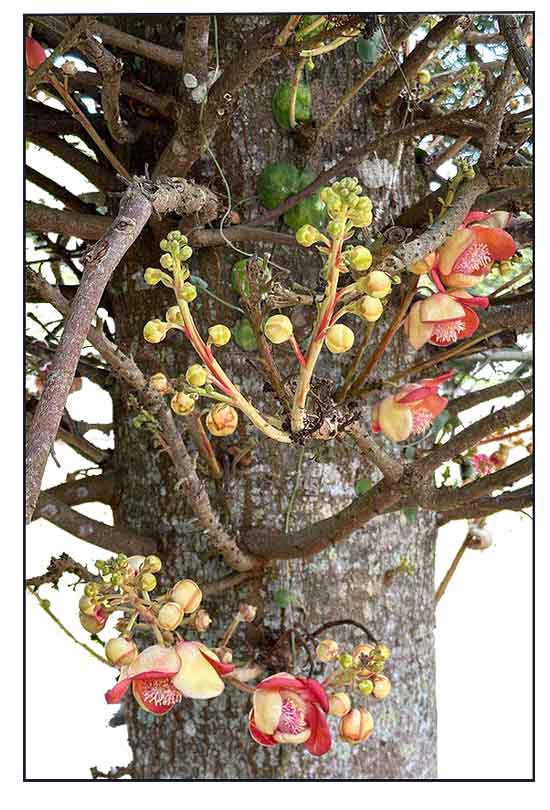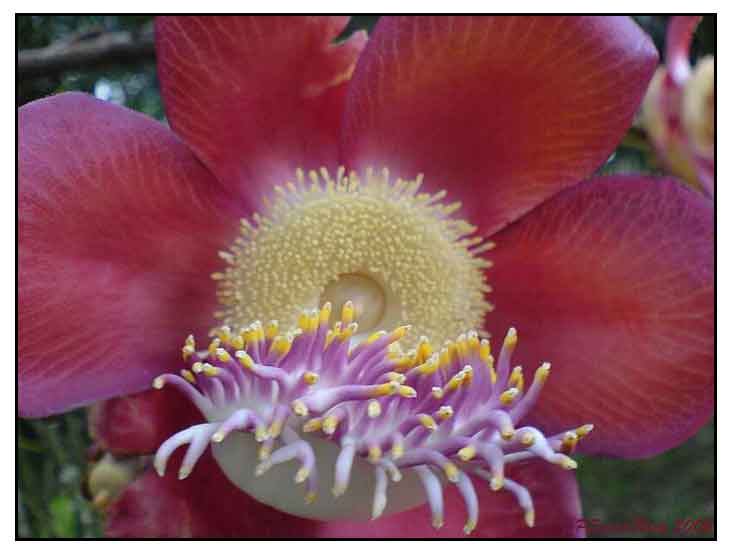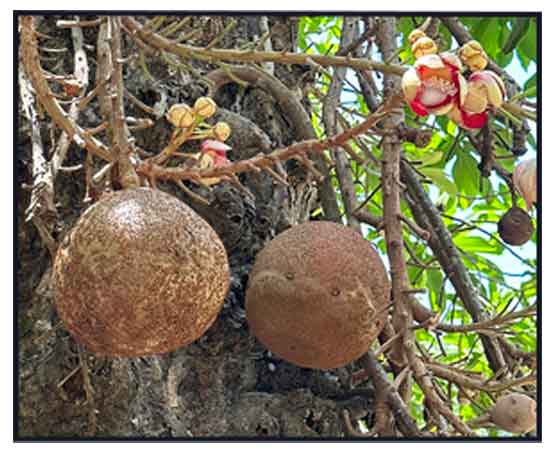 Gen info Gen info
- In India, considered a sacred tree. The flower has been proclaimed as the State Flower by the government of Puducherry, Union Territory of india. (41)
- The curved staminal sheath of the flower over the pistil resembles Linga, a sacred snake protecting Lord Shiva, hence, its use in the worship of the Lord Shiva and widely decorating temples. (41)
 Botany Botany
Cuoropita guianensis is a large evergreen tree growing to a height of 20 meters. Leaves are alternate, oblong-obovate, up to 20 centimeters long, entire to slightly serrate and hairy on the veins beneath. Inflorescence is racemose, arising from the trunk and other large branches. Flowers are reddish with a yellow tinge on the outside, fragrant, with stamens borne on an overarching androphore. Fruit is a large, reddish-brown globose, 15 to 24 centimeters, with a woody capsule, and each containing 200 to 300 seeds.
Distribution
- Recent introduction.
- As ornamental trees along highways and in parks.
- Planted as curiosity tree in botanical gardens.
- Native to tropical northern South America, especially the Amazon rainforest, and the southern Carribean.
- Also occurs in India, where it is probably native, and Thailand.
Constituents
- Flowers yield an alipathic hydrocarbon and stigmasterol.
- Flowers yielded alkaloids, phenolics and flavonoids.
- Yielded active principles isatin and indirubin (vital to its antimicrobial activity).
- Phytochemical screening yielded flavonoids: 2',4'-dihydroxy-6'-methoxy-3',5'-dimethylchalcone, 7-hydroxy-5-methoxy-6,8-dimethylflavanone and the phenolic acid 4-hydroxybenzoic acid.
- Fractionation studies of leaves yielded three compounds: (1) compound 1, mp 79–81°C (2)
Compound 2, mp 95–97°C, and (3) Compound 3, mp 273–275°C. (see studies below) (9)
 - Crude methanolic extract of leaves yielded carbohydrates, protein, alkaloids, terpenoids, phenolic compounds, reducing sugar, and triterpenoids. It was negative for amino acids, flavonoids, tannin, phlobatannins, aromatic acids and xanthoproteins. (see study below)
(17) - Crude methanolic extract of leaves yielded carbohydrates, protein, alkaloids, terpenoids, phenolic compounds, reducing sugar, and triterpenoids. It was negative for amino acids, flavonoids, tannin, phlobatannins, aromatic acids and xanthoproteins. (see study below)
(17)
- Fractionation of alcoholic leaf extracts isolated flavonoids viz., 2',4'-dihydroxy-6'-methoxy-3',5'-dimethylchalcone (1), 7-hydroxy-5-methoxy-6,8-dimethylflavanone (2) and the phenolic acid 4-hydroxybenzoic acid (3). (see study below) (20)
- Various extracts of fruits were studied for volatile and semi-volatile compounds. Linalool, benzyl alcohol, terpineol, hexadecanoic acid and the cis- and trans-furan linalool oxides were the most abundant compounds of the total aqueous extract fraction. Linalool and its oxides, terpineol, benzoic acid and 7-methoxy-coumarin were identified as the pleasant odor-active compounds, and benzothiazole as an off-flavor compound. Linalool, 2-ethylhexanol and limonene were the major compounds found in the headspace fraction. (25)
- Phytochemical analysis of ethanol extracts of leaves (L), flowers (F) and fruits (Fr) yielded carbohydrates, alkaloids, proteins and amino acids, theobromine, glycosides, phytosterols, flavonoids, tannins, and terpenoids, with absence of saponin.
(37)
- Study of various extracts of flowers for phytoconstituents yielded a new compound cycloart-24-3n-3-0l-4-exomethylenne heptadeconate (1), along with stigmasterol (2), p-coumaric acid (3), o-coumaric acid (4), caffeic acid (5), and quercetin (6).
(42)
Properties
- Considered antibiotic, antifungal, antiseptic, and analgesic.
- Studies have shown antimicrobial, antioxidant, antinociceptive, wound healing, hepatoprotective, anti-inflammatory, anti-quorum sensing, antidepressant, repellent, anxiolytic, antiulcer properties.
Parts used
Juice, leaves, fruit.
 Uses Uses
Edibility
- Fruits are edible, but only occasionally eaten because of the unpleasant odor of the white flesh.
- In the Amazon,
leaves, bark, and flowers used as medicinal tea infusions.(41)
Folkloric
- No known medicinal use in the Philippines.
- Elsewhere, used to treat colds and stomachaches.
- Juice from leaves used for skin diseases.
- Shamans of South America used tree parts for malaria.
- Fruit pulp used to disinfect wounds.
- Young leaves used for toothache.
- Used for treatment of tumors.
- In South America, used for the treatment of pain and inflammatory disorders.
- In Ayurveda, fruit juices used as expectorant in acute or chronic cough and in bronchitis.
- Native Amazons use the plant to treat hypertension, tumors, inflammation, and pain.
- In the Amazon region and in Brazil, tea infusions of leaves, bark and flowers used for treatment of hypertension, tumor, pain, and inflammation. Infusion of flowers used as immunobooster. Leaves, roots and bark used by Shamans of South America for treatment of malaria.(41)
- Leaves used as snuff in powdered form. (41)
- In India, the Kailasagirikona tribes and Yanadi tribes used the leaves as hair stabilizer. (41)
Others
- Religious / Ritual: (1) Hindus consider it a sacred tree as the petals of the flowers resemble the sacred snake, Naga, a cobra protecting a Shiva Lingam with its hood. (2) In some parts of India, the tree is worshiped by childless couples.
- Fragrance: Fragrant flowers can be used to scent perfumes and cosmetics.
- Wood: (1) Hard shells of the fruit sometimes used as containers and utensils. (2) Wood used for making incense.
- Shell: Used as drinking vessel.
 Studies Studies
• Antimicrobial / Antioxidant: Study showed antimicrobial activity against Shigella flexneri, Staph aureus and Candida albicans. The phenolic and flavonoid fractions showed strong antioxidant potential.
• Antinociceptive: Study evaluated crude ethanol extract and its fractions for antinociceptive activity in three analgesic models: acetic acid induced contortions, tail flick, and hot plate method. Results showed Couroupita guianensis exhibited nociceptive activity mediated, in part, by opioid and cholinergic systems and the nitric oxide pathway. (4)
• Wound Healing / Antimicrobial: Study of ethanolic extract of whole plant of CG (bark, leaves, flowers and fruits) on excision and incision wound models showed acceleration of the wound healing process by reduction of surface area of the wound and increasing tensile strength. Moderate activity was observed against all test organisms. (5)
• Anthelmintic / Flowers: Study tested the activity of chloroform, acetone and ethanolic flower extracts of CG for anthelmintic activity against adult earth worm, Pheritima posthuma. The alcoholic extract was the most effect in an activity comparable with Piperazine citrate.
• Skin Fibroblast Proliferation / Antioxidant: Study of hydroalcoholic extract strongly indicated antioxidant activity attributed to phenolic content. Also, significant stimulation of HSF proliferation and absorption of UV radiation was noted. Results suggest promising skin care properties. (6)
• Antidepressant / Leaves: Fractionation study of leaves yielded 3 compounds. Compound 3, a triterpene alcohol, showed potential anti-depressant activity using tail-suspension test and despair swim test in mice. (see constituents above) (9)
• Neuropharmacological Effects: Study evaluated a methanolic extract of C. guianensis on spontaneous motor activity, rota-rod performance and phenobarbital sleeping time in mice. Results showed significant dose dependent reduction in spontaneous motor activity with no effect on motor coordination. There was also reduction of onset and duration of pentobarbitone induced hypnosis. Results suggest effects on both central and peripheral nervous system. (10)
• Antioxidant / Antimicrobial / Fruit Rind: Study of various extracts of fruit rind showed significant antibacterial and antifungal activity against major microbes (S. aureus, E. coli, Micrococcus sp., C. diphtheria, Candida albicans). Results also showed strong antiradical activity in the DPPH assay. (11)
• Antioxidant / Antimicrobial: Study evaluated an ethanolic extract of fruit rind of Couroupita guianensis for safety profile by acute toxicity study in Swiss albino mice. The oral medium lethal dose (LD50) was found to be 200 mg/kg, 400 mg/kbw for the first 72 hours to 14 days. Tested on HepG2, Vero cell lines, MCF 7 cell lines and HT 29 cell lines by MTT assay, the EE showed significant dose
• Hepatoprotective / Antioxidant / Leaves: Study of ethanolic leaf extract of C. guianensis showed a significant hepatoprotective effect against CCl4-induced liver damage in rats, in comparison with standard silymarin. (15)
• Antioxidant / Anti-Arthritic / Anti-Platelet / Leaves: Study evaluated a methanolic extract of CG leaves for in vitro antioxidant, antiarthritic and anti-platelet activities.
dependent antiproliferative activity. (16)
• Antibacterial / Leaves: Study evaluated the antibacterial potential of methanolic extract of leaves against clinical pathogens. Activity was found against E. coli, Pseudomonas putida, S. aureus, and K. pneumonia. It showed potential activity against Staphylococcus aureus (NCIM 5021) and can be utilized for preparation of wound healing ointments. (see constituents above) (17)
• Repellency / Silverleaf Whitefly / Leaves: Study evaluated an aqueous extract of Couroupita guianensis for insecticidal activity and repellency against eggs, nymphs, and adults of Bemisia tabaci on greenhouse-grown tomato plant. Results showed low insecticidal effects of B. tabaci eggs, with greater effects on nymphs and adults. Results suggest C. guainensis extracts can be used as an effective and environmentally sustainable bio-insecticide for the control of whiteflies, Bemisia tabaci. (18)
• Antioxidant / Antimicrobial / Flowers: Study evaluated the antioxidant potential and antibacterial activity of methanol extract of flowers of C. guainensis. Results showed high reducing capacity and significant antibacterial activity, and suggests C. guainensis flowers as a good source of natural antioxidants. (19)
• Protective Effect Against Oxygen Reactive Species and Skin Fibroblast Stimulation / Leaves: Study evaluated hydroalcoholic leaf extract for antioxidant activity, phytochemicals, total phenolic composition, stimulation of human skin fibroblast (HSF) proliferation and UV-absorption. Results indicate strong in vitro antioxidant activity, which may be due to its high phenolic content. Also, there was a high level of stimulation of HSF proliferation and significant absorption of UV radiation. Results suggest promising skin care properties. (see constituents above) (20)
• Anti-Inflammatory / Leaves: Study evaluated an ethanol extract and fractions for anti-inflammatory activity in formalin-induced licking and carrageenan induced peritonitis models. Results showed an anti-inflammatory activity partly due to reduction of cell migration and inhibition of cytokines and inflammatory mediators production. (21)
• Anti-Inflammatory / Analgesic / Flowers and Bark: Study evaluated the analgesic (tail flick method) and anti-inflammatory activity (carrageenan induced paw edema) of various extracts of flowers and bark of Couroupita guainensis. Results showed analgesic activity equipotent to paracetamol and anti-inflammatory activity equipotent to indomethacin. (22)
• Antidepressant / Flowers / Flowers and Bark: Study evaluated aqueous and methanolic extracts of Couroupita guainensis flowers for antidepressant activity. Both extracts at higher concentration showed significant reduction in immobility in tail suspension and forced swim model of depression comparable to imipramine. (23)
• Zinc Oxide Nanoparticles: Study reports on eco-friendly, time-conservative, cost-effective green synthesis of zinc oxide nanoparticles using aqueous extracts of leaf, stem, flower petals and bark of Couroupita guainensis. (24)
• Neuropharmacological Effects / Flowers: Study evaluated a methanolic extract neuropharmacologic effects by spontaneous motor activity, rota-rod performance and phenobarbital sleeping time in mice. Results showed dose-dependent reduction in spontaneous motor activity with no effect on motor coordination by rotarod testing. There was also reduction in onset and duration of pentobarbitone induced hypnosis. Results suggest central and peripheral nervous system effects. (26)
• Antimicrobial / Antibiofilm Forming Activity / Fruits: Chloroform extract of fruits were investigated for antimicrobial, antimycobacterial, and antibiofilm forming activities. Results showed good antimicrobial and antibiofilm forming activities; however it showed low antimycobacterial activity. (27)
• Herbal Expectorant / Leaves: Fresh leaves juice used by some local Ayurvedic practitioner as expectorant in acute and chronic cough and in bronchitis. Study reports on the development of an herbal syrup from Couroupita guainensis. (28)
• Silver Nanoparticlesc/ Antioxidant / Antibacterial / Flowers: Study reports on the synthesis of flower mediated silver nanoparticles. Couroupita guianensis, silver ion and silver based compounds are highly toxic to microorganisms showing a strong biocidal effect against microbial species (Pseudomonas aeruginosa, Bacillus subtilis, Staphylococcus aureus, Klebsiella pneumonia, and E. coli). Study also showed enhanced DPPH scavenging activity. (29)
• Absorption of Copper from Industrial Waste: Study showed chemically prepared activated Couroupita guianensis carbon can be used as adsorbent material for the removal of Copper (III) from industrial waste water. (30)
• Indigo Dye / Flowers and Fruits: Cannon ball tree flowers and fruits are known to contain indigotin and indirubin. Study reported on the extraction of indigo from CG fruit and application of the crude extract on cotton fabric. Thin layer chromatography yielded three pigments: violet, blue, and pink with Rf values of 0.88, 0.57, and 0.25 respectively. The % purity of the indigo dye was 26.46%. Dyeing of cotton fabric with crude dye powder gave comparable fastness properties vis-a-vis synthetic indigo. (31)
• Quorum Sensing against Enterobacter aerogens: Bacteria make use of cell-cell signaling system known as Quorum Sensing (QS). Study evaluated the anti-quorum sensing efficacy of Couroupita guainensis against Enterobacter aerogenes, estimated with reference to QS Biomonitoring strain Chromobacterium violaceum and Pseudomonas aeruginosa. Docking studies revealed the necessary crucial hydrogen bond interactions with critical amino acids and that the compound CID_641785 with the highest binding score might be an effective inhibitor of Enterobacter aerogenes pathogenesis. (32)
• Anxiolytic / Flowers: Study evaluated aqueous and methanol extracts of CG for anxiolytic activity in Swiss albino mice using elevated plus maze (EPM), light and dark (LD), and open field test (OFT) models. Both extracts of CG at a dose of 500 mg/kg showed significant anxiolytic activity in the three models in mice. (33)
• Antiulcer / Leaves: Study evaluated the antiulcer activity of ethanolic extract of Couroupita guianensis leaves in pylorus ligation and ethanol induced ulcer models in experimental rats. Results showed a significant inhibition of gastric lesions induced by pylorus ligation induced ulcer and ethanol induced gastric ulcer, with significant (p<0.05) reduction in gastric volume, free acidity, and ulcer index as compared to control. The antiulcerogenic property may be due to its antisecretory activity. (34)
• Isatin / Antioxidant / Anticancer / Flowers: Isatin (1H-indole-2,3-dione) has been isolated from the flowers of Couroupita guianensis. Isatin derivatives are known to have cytotoxicity against human carcinoma cell lines with a potential as chemotherapeutic agent against cancer. In this study, isatin from the active fraction showed antioxidant activity with EC50 value of 72.80 µg/ml and exhibited cytotoxicity against human promyelocytic leukemia HL60 cells in dose-dependent manner with CC50 value of 2.94 µg/ml. The isatin-treated cells underwent apoptosis and DNA fragmentation. (35)
• Ovicidal Activity against Spodoptera litura / Leaves: Study evaluated various extracts of CG leaves for ovicidal activity against Spodoptera litura. Maximum activity was noted in the hexane extract with the least LC50 and LC90 values. (36)
• Silver Nanoparticles / Antibacterial / Antioxidant / Flowers, Leaves, and Fruits: Study evaluated various extracts of leaf, flower, and fruit for phytochemical contents. Silver nanoparticles were synthesized from these parts. All extracts, except for aqueous extracts, exhibited good antioxidant and antibacterial activity. Use of the flower extract resulted in more efficient synthesis of AgNPs compared to leaf and fruit extracts. Flower mediated nanoparticles showed better results attributed to certain phytochemical compounds responsible for the reduction and capping of silver nanoparticles. (see constituents above) (37)
• Antimicrobial: Study evaluated the antimicrobial activity of methanol extracts of C. guainensis leaves, flowers, fruit, stem and root bark, and stem and rot heartwood. Most activity was seen in the petrol fraction of flowers,fruit and stem bark, and ethyl acetate fraction of flowers and stem and root bark, and dichlormethane fractions of stem and root bark. (38)
• Gold Nanoparticles / Antioxidant / Fruit: Study reported on the instant green synthesis of anisotropic gold nanoparticles using fruit extract of C. guianensis. In vitro antioxidant assays showed the aqueous extract and formulated AuNPs possess extraordinary antioxidant properties. Histocompatibility assay showed the safe nature of the gold nanoparticles. (39)
• Antiurolithiatic / Antioxidant / Leaves: Study evaluated an aqueous extract of C. guianensis for its capability to dissolve calcium oxalate crystal in in vitro conditions. Results showed antiurolithiatic activity probably mediated through the inhibition of calcium oxalate cyrstallization and, in addition, its free radical scavenging and antioxidant activities. (40)
• Larvicidal Against Helicoverpa armigera: Study evaluated the bioefficacy of crude extracts and fractions of Couroupita guianensis against third instar larvae of Helicoverpa armigera. Results showed maximum feeding deterrency of 81.67% and least LC50 of 2.72% for larval mortality in the hexane extract Fraction 8 showed maximum antifeedant activity of 86.24% and larvicidal activity of 80.88% at 1,000 mg/kg concentration. Results suggest potential for use in pest control programs. (43)
Availability
- Wild-crafted.
- Leaves, seeds, and plant parts in the cybermarket.
|

![]()



 Gen info
Gen info Botany
Botany - Crude methanolic extract of leaves yielded carbohydrates, protein, alkaloids, terpenoids, phenolic compounds, reducing sugar, and triterpenoids. It was negative for amino acids, flavonoids, tannin, phlobatannins, aromatic acids and xanthoproteins. (see study below)
(
- Crude methanolic extract of leaves yielded carbohydrates, protein, alkaloids, terpenoids, phenolic compounds, reducing sugar, and triterpenoids. It was negative for amino acids, flavonoids, tannin, phlobatannins, aromatic acids and xanthoproteins. (see study below)
(
 Studies
Studies 